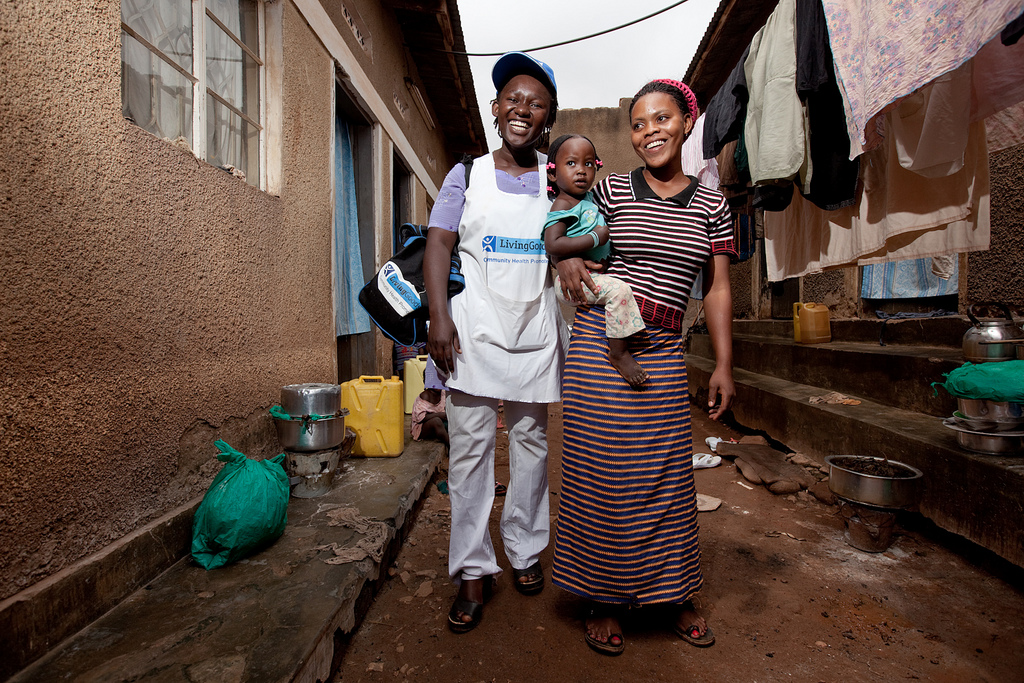Reducing Child Mortality with Community Health Promoters in Uganda
Abstract
Incentive-based community health worker model reaches millions.
“IPA recently completed a large-scale randomized study for Living Goods showing the model is reducing child deaths by a staggering 27 percent. The result has been nothing short of transformational. The power and quality of research has persuaded policymakers, replication partners, and major funders to back a rapid scale up of the approach. As a result, Living Goods’ reach has tripled to 5 million people served. Proof positive that IPA’s research can lead to disruptive change for those most in need.”
-Chuck Slaughter, Founder of Living Goods
The Challenge
Despite improvements in under-five child mortality, an estimated 5.9 million children worldwide died in 2015. More than half of those deaths were due to conditions that could have been prevented or treated with simple, affordable interventions.1 A majority of these deaths occur in the poorest countries in the world, among families with inadequate access to basic health services. An increasingly common approach to reaching these populations is through community health worker programs, which recruit and train members of a community to provide basic health and medical care to their community. However, existing community health systems—often comprised of unpaid, volunteer workers—have had mixed results in reducing child mortality.2 Weak incentives for community health workers to deliver timely and appropriate services may be factors limiting the effectiveness of these programs.3
The Evidence
An IPA study found that a social entrepreneurship community health worker model in Uganda, called Living Goods Community Health Promoters (CHP), substantially reduced child mortality, improved health knowledge and preventative care measures, and increased the number of visits that CHPs paid to households.
Living Goods, a U.S.-based non-profit organization, created the CHP program with the aim of improving access to and adoption of simple, proven health interventions in rural and peri-urban areas in Uganda.4 The program is carried out in partnership with the Bangladesh-based non-profit BRAC. Living Goods and BRAC entrepreneurial CHPs go door-to-door educating their community about ways to improve their health, diagnosing and treating illnesses, supporting pregnant women and newborns, and earning a small income from performance-based incentives and sales of impactful health products.

The three-year evaluation of the program found that it reduced under-5 mortality by 27 percent and infant (under-1) mortality by 33 percent.5 It also reduced neonatal mortality by 27 percent, on a base of 27.8 deaths during the first month of life per 1,000 live births.
The CHP program also improved health knowledge and people in program villages reported taking more preventative health measures than those in the comparison group. In addition, households with newborns in program villages were significantly more likely to have received follow-up visits, in relation to households in comparison villages that didn’t receive the program.
The Impact
The findings have persuaded policymakers and funders to scale up the model, enabling Living Goods to expand the program to reach millions across Uganda and to bring the successful model to Kenya and provides promising insight into strengthening community health systems. IPA is currently evaluating this program at scale to see if the same impacts persist when the program is brought to scale. We are also exploring evaluating the approach in other contexts to validate the model, and are currently engaging in conversations with researchers and funders to this end.
Read more about how the program works in this blog post by the researchers, and more about the methods and results in the project summary.
The founder of Living Goods is a financial supporter of IPA. IPA conducts evaluations independently in the field, led by external, unaffiliated researchers. Neither partners nor funders influence results.
---
Watch a video where researcher Nava Ashraf talks about the importance of self-selection of public sector workers and what her research found in Zambia.
This work is licensed under a Creative Commons Attribution 4.0 International License.
Sources
[1] WHO. Children: reducing mortality. September 2016.
[2] Lewin, Simon, Susan Munabi-Babigumira, Claire Glenton, Karen Daniels, Xavier Bosch-Capblanch, Brian E. van Wyk, Jan Odgaard-Jensen et al. “Lay health workers in primary and community health care for maternal and child health and the management of infectious diseases.” Cochrane Database Syst Rev 3 (2010).
[3] “Community and Formal Health System Support for Enhanced Community Health Worker Performance: A U.S. Government Evidence Summit” USAID Final Report 2012.
[4] The founder of Living Goods is a financial supporter of IPA. IPA conducts evaluations independently in the field, led by external, unaffiliated researchers. Neither partners nor funders influence results.
[5] Researchers measured under-5 and infant (under-1) mortality as mortality rate per 1000 years of exposure to the risk of death during the evaluation. The number of months of exposure is defined as the difference between the birth date of the child, or the start date of the trial if the child was born before that date, and the date that the child turned five (one for infant mortality) if that occurred during the trial period, or the date of the endline household survey if the child was less than five (one) years old at that time, or the date of the death of the child.












